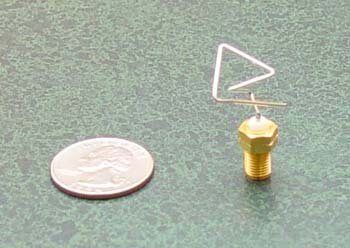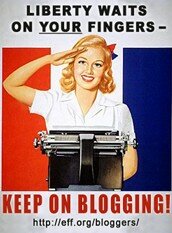February 2006
Monthly Archive
Sat 25 Feb 2006
Posted by glenn under
Government
Andy Lines, Mirror.co.uk, reports:
ROCK star Morrissey has revealed he was quizzed by the FBI and Special Branch over his criticism of the US and Britain.
Morrissey, 46, has previously branded George Bush a terrorist and blasted the Iraq war.
The ex-Smiths singer, who lives in Los Angeles, said: “The FBI and Special Branch have investigated me and I’ve been interviewed and taped.
(more…)
Thu 23 Feb 2006
Posted by glenn under
Hardware

NASA, via BoingBoing, reports:
Like a friendly, non-biological form of the Borg Collective of science fiction fame, 80 personal computers, using artificial intelligence (AI), have combined their silicon brains to quickly design a tiny, advanced space antenna.
If all goes well, three of these computer-designed space antennas will begin their trip into space in March 2006, when an L-1011 aircraft will take off from Vandenberg Air Force Base in California. The airplane will drop a Pegasus XL rocket into the sky high above the Pacific Ocean. The rocket will ignite and carry three small Space Technology (ST5) satellites into orbit.
Each satellite will be equipped with a strange-looking, computer-designed space antenna. Although they resemble bent paperclips, the antennas are highly efficient, according to scientists.
“This is the first time an artificially evolved object will have flown in space,” observed Jason Lohn, who led the project to design the antennas at NASA Ames Research Center, located in California’s Silicon Valley.
(more…)
Wed 22 Feb 2006
Posted by glenn under
Art

A Cornell University student, via BoingBoing, reports:
A Cornell University student’s research project titled “Schizophrenia, Aging and Art” profiles Louis Wain, an early 20th century artist who began to suffer from schizophrenia late in life. While a commercial artist, he drew lots of comics of cats that appeared in newspapers and children’s books. From the project’s Web site:
During the onset of his disease at 57, Wain continued to paint, draw and sketch cats, but the focus changed from fanciful situations, to focus on the cats themselves.
Characteristic changes in the art began to occur, changes common to schizophrenic artists. Jagged lines of bright color began emanating from his feline subjects. The outlines of the cats became sever and spiky, and their outlines persisted well throughout the sketches, as if they were throwing off energy.
Soon the cats became abstracted, seeming now to be made up of hundreds of small repetitive shapes, coming together in a clashing jangles of color that transform the cat into something resembling an Eastern diety.
The abstraction continued, the cats now being seen as made up by small repeating patterns, almost fractal in nature. Until finally they ceased to resemble cats at all, and became the ultimate abstraction, an indistinct form made up by near symmetrical repeating patterns.
Wed 22 Feb 2006
Posted by glenn under
Info Tech
New Scientist, via Slashdot, reports:
Even for the crazy world of quantum mechanics, this one is twisted. A quantum computer program has produced an answer without actually running.
The idea behind the feat, first proposed in 1998, is to put a quantum computer into a “superposition”, a state in which it is both running and not running. It is as if you asked Schrödinger’s cat to hit “Run”.
With the right set-up, the theory suggested, the computer would sometimes get an answer out of the computer even though the program did not run. And now researchers from the University of Illinois at Urbana-Champaign have improved on the original design and built a non-running quantum computer that really works.
(more…)
Sat 18 Feb 2006
Hand waving boosts mathematics learning
Posted by glenn under
Education
Roxanne Khamsi (St Louis), NewScientist.com news service, via BoingBoing, :
Gestures that complement rather than simply illustrate verbal instructions can boost children’s ability to complete problems in mathematics, researchers report.
“The teachers are giving the kids two different approaches to the problem - one by hand and one by mouth - and somehow they seem to complement one another,” says Susan Goldin-Meadow of the University of Chicago, US. She adds that early findings also show that students who copy the gestures of their teachers are more likely to learn.
Goldin-Meadow and her colleagues gave 160 children between the ages of eight and 10 a set of mathematical problems to solve. The students were randomly assigned to receive either verbal instructions alone or also with gestures. Those in the latter group either received gestures that copied or complemented the spoken guidance.
As part of the experiment students had to complete the equation “7+6+5=?+5”. Teachers told the youngsters that they had to make one side of the equation match the other side.
The gestures simply duplicating these directions involved the instructors pointing to the left-hand and then the right-hand sides of the equation. When using complementary gestures, however, the teachers pointed to each of the numbers on the left and then signalled the subtraction of the five on the right side by scooping their hand away from the number.
Sign of success
Children who saw the complementary gestures did best, solving three of the four addition problems correctly, on average. By comparison, those children who witnessed simple illustrative gestures typically solved fewer than two of the problems correctly. And students who received only verbal instructions solved only one of the four problems correctly, on average.
(more…)
Fri 17 Feb 2006
The Ugly Face of Crime
Posted by glenn under
Culture
Richard Morin, Washington Post, via BoingBoing, reports:
“I’m too ugly to get a job.”
– Daniel Gallagher, a Miami bank robber, after police captured him in 2003
The hapless Mr. Gallagher may have been ugly, but he was also wise.
Not only are physically unattractive teenagers likely to be stay-at-homes on prom night, they’re also more likely to grow up to be criminals, say two economists who tracked the life course of young people from high school through early adulthood.
“We find that unattractive individuals commit more crime in comparison to average-looking ones, and very attractive individuals commit less crime in comparison to those who are average-looking,” claim Naci Mocan of the University of Colorado and Erdal Tekin of Georgia State University.
(more…)
Fri 17 Feb 2006
Policing Porn Is Not Part of Job Description
Posted by glenn under
Government
Cameron W. Barr, Washington Post Staff Writer, reports:
Two uniformed men strolled into the main room of the Little Falls library in Bethesda one day last week and demanded the attention of all patrons using the computers. Then they made their announcement: The viewing of Internet pornography was forbidden.
The men looked stern and wore baseball caps emblazoned with the words “Homeland Security.” The bizarre scene unfolded Feb. 9, leaving some residents confused and forcing county officials to explain how employees assigned to protect county buildings against terrorists came to see it as their job to police the viewing of pornography.
After the two men made their announcement, one of them challenged an Internet user’s choice of viewing material and asked him to step outside, according to a witness. A librarian intervened, and the two men went into the library’s work area to discuss the matter. A police officer arrived. In the end, no one had to step outside except the uniformed men.
(more…)
Thu 2 Feb 2006
Western Union Stops Sending Telegrams
Posted by glenn under
Info Tech
Robert Roy Britt, LiveScience Managing Editor, via Slashdot, reports:
After 145 years, Western Union has quietly stopped sending telegrams.
On the company’s web site, if you click on “Telegrams” in the left-side navigation bar, you’re taken to a page that ends a technological era with about as little fanfare as possible:
“Effective January 27, 2006, Western Union will discontinue all Telegram and Commercial Messaging services. We regret any inconvenience this may cause you, and we thank you for your loyal patronage. If you have any questions or concerns, please contact a customer service representative.”
(more…)
Wed 1 Feb 2006
Subscriber credit data distributed by mistake
Posted by glenn under
Info Tech
Robert Gavin, Globe Staff :
Credit and bank card numbers of as many as 240,000 subscribers of The Boston Globe and Worcester Telegram & Gazette were inadvertently distributed with bundles of T&G newspapers on Sunday, officials of the newspapers said yesterday.
The confidential information was on the back of paper used in wrapping newspaper bundles for distribution to carriers and retailers. As many as 9,000 bundles of the T&G, wrapped in paper containing subscribers’ names and their confidential information, were distributed Sunday to 2,000 retailers and 390 carriers in the Worcester area, said Alfred S. Larkin Jr., spokesman for the Globe.
In addition, routing information for personal checks of 1,100 T&G subscribers also may have been inadvertently released.
(more…)



